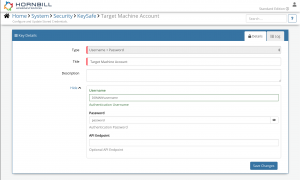Exchange Server Unified Messaging Management (OnPremise)
| Home > Administration > IT Operations Management > ITOM Package Library > Exchange Server Unified Messaging Management (OnPremise) | Index |
Introduction |
{{{2}}} |
Target Environment Requirements
Script Execution Machine Requirements
- If the script execution policy on the machine executing these operations is set to Restricted, then this will need to be updated to something less restrictive. If this is the case, you can use the Set Execution Policy operation within this package to update the Execution Policy on the target device before peforming any of the other operations.
KeySafe Configuration
When creating SIS jobs for operations contained within this package, they need to be run on the target machine as a user who has the correct privileges on the target.
To configure your Target Machine account authentication in KeySafe:
- In the Admin console, navigate to: System > Security > KeySafe;
- Click on + then select
Username + Password; - Give the KeySafe Key a Title (this is the name/identifier for the target machine account as you will see it when creating an IT Automation Job, or adding an IT Automation node to a Business Process or Runbook);
- Optionally add a description;
- Populate the Username field with the domain/local account username for the account being used on the target machine;
- Populate the Password field with the password for the above account;
- Select Create Key to save.
Once you have created your KeySafe Key, you can then use it when creating IT Automation Jobs from this package. See screenshots to the right for examples.
Package Operations
The Exchange Server Unified Messaging Management (OnPremise) package contains the following operations, than can be used to create ITOM Jobs directly, or included in your Business Processes and/or IT Operations Management Rubooks.
Enable UM Mailbox
Enables a Mailbox to utilise Unified Messaging, with the settings from a UM mailbox policy applied. After allowing the mailbox for use with Unified Messaging, the user can use the UM features included in Microsoft Exchange.
Input Parameters
IdentityMANDATORY - Specifies the mailbox that you want to view. You can use any value that uniquely identifies the mailbox: Name, Alias, Distinguished name (DN) etc...Extensions- Specifies the extension number for the user. Either a single extension number or a comma separated list can be specified.Pin- Specifies the value for the initial PIN that's used for the UM mailbox.NotifyEmail- Specifies the email address where the Unified Messaging welcome message is sentPinExpired- Specifies whether the PIN is treated as expired, and will need to be reset on the next loginUMMailboxPolicyMANDATORY - Specifies the UM mailbox policy that you want to associate with the mailbox.: Name, Distinguished name (DN) ,GUID etc.SIPResourceIdentifier- Specifies the SIP address or E.164 address for the user.DomainController- Specifies the domain controller that's used to read data from or write data to Active DirectorySendWelcomeMail- specifies whether you want to send a welcome message after the mailbox has been enabled for UM.
Output Parameters
outcomeThe outcome of the operation (OK/FAIL)errorsAny errors returned by the operation
Disable UM Mailbox
Disables a Mailbox from utilising Unified Messaging; the user can no longer use the UM features included in Microsoft Exchange. Microsoft Exchange Unified Messaging service no longer handle calls for the associated extension number. The mailbox continues to function normally for all other operations unrelated to Unified Messaging.
Input Parameters
Identity- Specifies the mailbox that you want to view. You can use any value that uniquely identifies the mailbox: Name, Alias, Distinguished name (DN) etc...DomainController- Specifies the domain controller that's used to read data from or write data to Active Directory
Output Parameters
outcomeThe outcome of the operation (OK/FAIL)errorsAny errors returned by the operation

